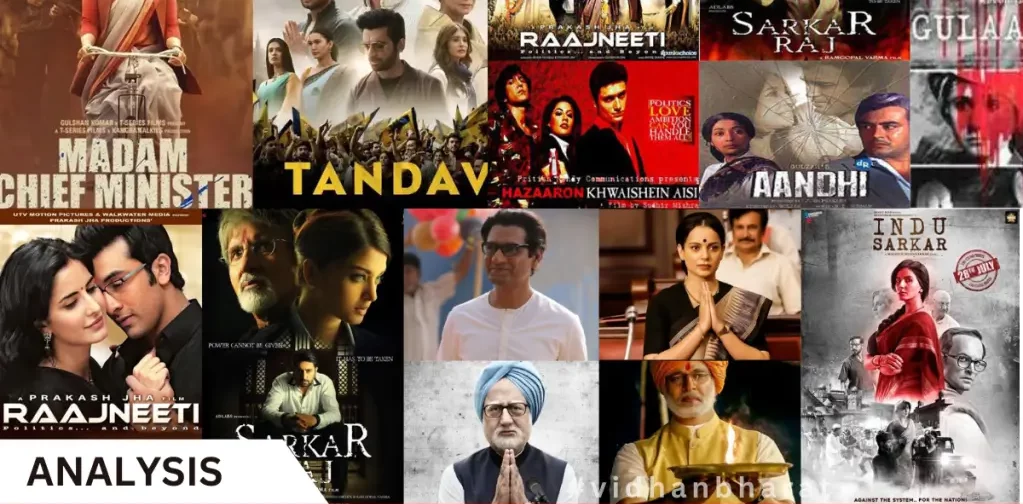
- Home
- About
- Knowledge Center
- Legislative Landscape
- Resources
- #TOGETHERFORBHARA
Are politicians really as bad as they are shown in movies?
What’s wrong with Indian politics and Indian cinema?
Does politics work like shown in the movies? Is cinema ruining Indian Politics?
These are some of the questions that come up when we look into how Indian films and politics are connected.
The depiction of politics in Bollywood, the Indian film industry, has been the subject of mystery and criticism for a longer period. In this article, we shall examine the multifaceted factors that influence the depiction of politics in films. When we look at Indian cinema through the lens of law, we look at the many factors that affect how politics are portrayed, how these depictions relate to real-life problems with law, and government, and whether these depictions are genuine.
Films as a mirror of realpolitik:
Movies often show what’s happening in society and politics. They act as a mirror, showing us what people hope for, what disappoints them, and what they think about their elected representatives. When Indian movies talk about politics, they often show what’s happening in the government and how it affects people’s lives. It is essential to note that these portrayals often lean towards the negative.
Corruption and the cinematic drama:
One of the primary reasons behind this stereotypical depiction of politics is the unprincipled behaviour of our elected representatives and the indulgence in corruption among other things. Moviemakers get ideas from these problems and use them to create interesting stories that people want to watch. Amitabh Bachchan’s role as a ‘cold and corrupt’ politician in the film Sarkar (2005) substantiates the above argument. This character was a lot like what people think corrupt politicians are like, and it made the movie interesting for the audience.
Even though these depictions may appear exaggerated, they bring attention to a significant problem in India. People have lost faith in the political system due to controversies involving politicians. By dramatising these issues in films, Indian cinema attempts to demonstrate the need for strict enforcement of legislation against graft, and corrupt practices.
Portrayal of People’s emotions
Filmmakers often take into consideration how most people feel about the issues around them. Politicians are portrayed poorly in films since the general populace is disappointed with their involvement in scandals, corruption, and poor performance.
Negative image as a catalyst of Social change
Indian films are known to drive social points. Film directors use political subjects to highlight burning problems in society. By doing so, they might use negative portrayals of lawmakers to draw attention to problems with the way politics work as a whole.
Prakash Jha’s 2013 movie “Satyagraha,” on corruption and the government system is a potent example. Amitabh Bachchan, the protagonist, who plays an activist, stands out for stepping up to corrupt politicians. This cinematic approach highlights the need for legislative reforms and better governance practices.
Complex Characterisation of individuals
Indian films are known to portray complicated characters with mixed morals. The movie “Raajneeti” (2010), directed by Prakash Jha displayed characters with shades of grey. The movie depicted the harsh realities of politics and the lives of politicians. In essence, there are no strictly good or bad politicians; they are complex individuals navigating a challenging political landscape.
Films and Politics: A link
Returning to the initial questions, we realise how complicated the connection is between Indian films and politics. It’s important to remember that Indian films are both art and entertainment, even though they often show leaders in a bad light for dramatic effect and social commentary. It’s important to remember that negative images don’t always show the truth. Instead, they should start conversations about problems of law and order.
Yes, Indian politics is full of problems. However, films are expected to act as means to think, discuss, and criticize. Negative depictions are essential for dramatic effects, but they also push for better governance. Both Indian cinema and politics are part of a larger social conversation. Their relationship evolves as they affect, and are influenced by one another. Essentially, movies serve as a reflection of Indian politics, and the political environment presents socio-economic issues that the film industry addresses to raise awareness among the general populace.